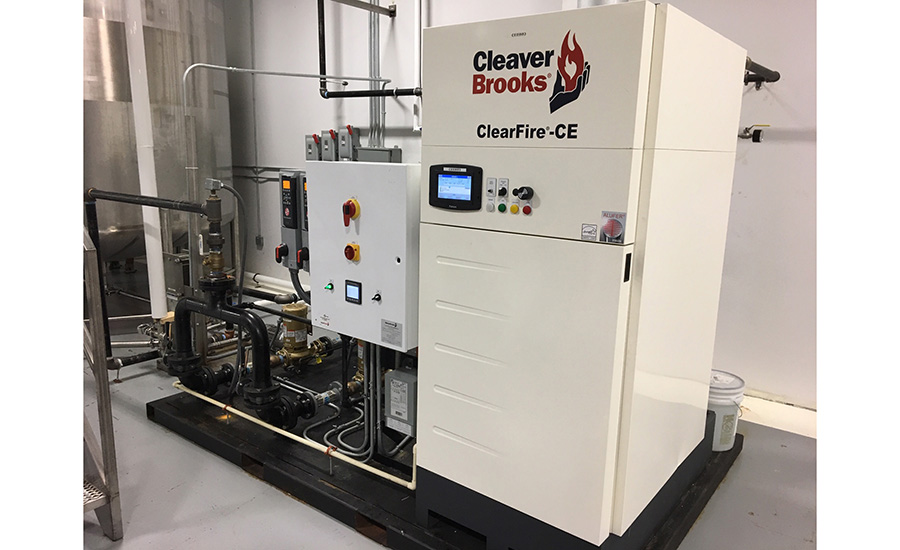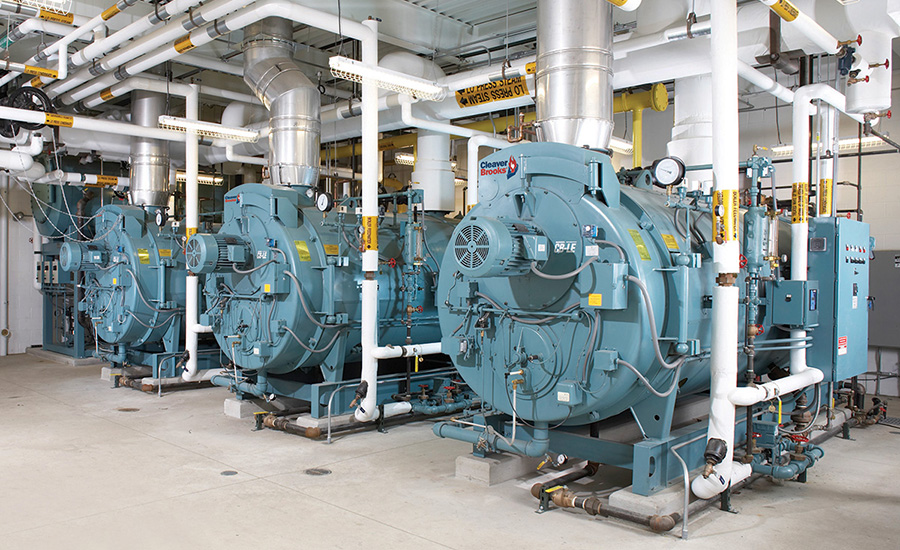Trends in Process Heating with Boiler Systems
Alternative approaches to process heating with steam or hot water boilers are leading some to wonder, “Are central boiler plants for process heating a thing of the past?” Maybe so, maybe not. But, before answering that question, this article will review the history of central plants and see how technology has influenced new approaches.
As businesses expanded into larger plants, buildings and campuses during the industrial revolution, so did the demand for both process heating and comfort heating. Typically, the boiler plants were fueled by coal, oil or, more recently, natural gas. In such instances, it was more practical — and often more efficient — to combine the process and comfort loads for one or multiple buildings and create a central plant.
Steam or Hot Water
When designing a central boiler plant, the first consideration is whether the application requires steam or hot water. Historically, central plants have focused on steam due to its high usable heat content, constant temperature property, self-motivating distribution and versatility. Of course, the nature of the process load ultimately determines whether steam or hot water is selected.
For example, suppose a brewery uses steam to heat its boil kettle. The process requires uniform heating throughout the kettle to ensure consistent product quality. This often is a low pressure steam application, sending 10 to 12 psi steam to the kettle jacket, where its latent heat is released. The latent heat enables the transfer of heat without a loss in temperature, providing precise temperature control throughout the kettle. As the steam condenses, the condensate is captured and returned to the boiler feed system.
For applications like kettle heating in a brewery, hot water is not as well suited. It is more difficult to maintain a consistent temperature of hot water when transferring sensible heat. This can lead to cold zones and loss of process control.
Once the decision has been made to design a steam plant, the next step is to look at the facility’s comfort-heating side. There are two options here: installing steam coils and traps throughout the design, or installing a steam-to-water heat exchanger with a hydronic distribution system. If the steam plant will serve only one building, the heat exchanger approach makes sense. If multiple buildings must be serviced from the same plant, however, the choice likely is steam distribution with coils at each zone.
As previously mentioned, steam is self-motivating. This means it will travel from high to low pressure without the need for pumps to transport it. This is another reason many engineers choose steam plants instead of hot water plants. In order to transport heated water, several large pumps are needed to move it throughout a facility. (Keep in mind, however, that the system steam operating pressure needed to distribute the steam usually will be higher than the pressure needed at the coils or process load. As a result, steam pressure regulators are required throughout the system.)
The advantage of designing a hot water system is that a hot water boiler is inherently more efficient; however, the system design may be more complex. Typically, the layout is a primary-secondary setup requiring additional pumps and valves to balance the system and to protect the heat-generating equipment. Because a hydronic system is considered a closed-loop system, it requires less maintenance and attention than a steam system. The steam plant, by contrast, is considered an open system, especially as it pertains to water treatment, boiler blowdown and condensate handling.
There are pros and cons to both system types. The initial cost varies between the two but, generally speaking, the central steam plant will command a higher investment than the hot water plant. These are not the only factors that should be considered when selecting the optimum system for the application, however.

Process hot water skid systems can provide benefits such as a compact footprint, application flexibility, portability and simplified installation and operation. Some manufacturers offer dedicated support for their skidded systems.
Combined vs. Separate Loads
Of course, technology and regulations influence design choices. Technology improvements can drive new regulations, and new regulations can drive technology improvements.
As boilers and burners became more efficient, central plants can make equipment upgrades to reduce energy costs and emissions. Eventually though, a point is reached where the laws of thermodynamics limit the boiler plant’s efficiency. As regulations continue to push for increased efficiency and reduced environmental impact, the focus has changed to heating processes that minimize energy consumption while improving productivity. A large steam plant can be very efficient in operation, yet a steam system requires attention and diligent maintenance. You easily can lose efficiency points if pipes remain uninsulated, system leaks develop and steam traps are neglected via poor maintenance or being allowed to fail. Also, if the central plant services multiple buildings, and the steam or hot water lines run underground, you must have access to service and maintain them. Even when insulated, there will be significant transmission losses.
Boiler system operator requirements may be another disincentive from the central steam plant approach. Large, high pressure steam systems almost always require licensed boiler operators on-site when the system is in operation. Many jurisdictions have operator exemptions on smaller-capacity or lower pressure boilers, however. Hot water boilers rarely require a licensed boiler operator.
Another point to consider is whether combining the process and comfort load is the best choice for the facility. While steam can provide precise temperature control for processes, a hot water system can deliver better efficiency and temperature control for HVAC — and some process applications. A central steam plant can support a hot water load with steam-to-hot-water heat exchangers, but it is inherently less efficient with the higher operating temperatures along with steam-to-condensate transition and blowdown losses.
The next logical step is to separate the two loads completely. Many processes still require steam’s unique properties. The comfort heating system, however, may be more efficient being served by hot water boilers.
The heating technologies of condensing boilers and heat pumps solidified hydronic heating as more efficient for HVAC, leading to splitting the comfort heating from the central plant. Removing the comfort heating aspect reduces the total load on a central steam plant.
Packaged Skid Solutions
In response to many of the developments discussed, an emerging trend in process heating is to install point-of-use steam or hot water generation equipment. In contrast to the central plant approach, smaller boiler systems can deliver the needed energy transfer right at the process location. These smaller steam or hot water systems may be self-contained boiler plants. They often are referred to as packaged skid solutions.
A packaged boiler skid consists of a boiler, or multiple boilers, and the requisite accessories to complete steam or hot water generation and distribution. The essential equipment is packaged on a common skid base and is prepiped and wired from the manufacturer, eliminating the need to perform these tasks at installation.
One benefit of point-of-use boiler solutions is the elimination of transmission losses over distance. This is unavoidable with the central plant approach. Distribution piping results in lost energy due to pressure drop as well as radiation and convection losses. For steam systems, there is the added necessity of steam traps at strategic locations as well as condensate receivers and condensate return piping back to the central plant. The self-contained, point-of-use packaged boiler skid minimizes or eliminates distribution and return piping or pumping requirements.
Another advantage of a packaged boiler skid is the ability to size the boiler system to match the specific process load. Central plants must be sized for the entire facility’s steam or hot water design loads. Rarely are all demands at design load at the same time. Partial-load operation of a large central plant can lead to operational inefficiencies and short cycling of equipment. In contrast, using multiple, modular boiler skid packages can provide a facility with several smaller load-sized systems that provide better overall system turndown to minimize short cycling. In some cases, the compact footprint enables boiler plants to be located right on the factory floor.
In addition, facility owners may benefit from the flexibility and reduced capital investment provided by point-of-use boiler systems. Facility processes invariably change. Sometimes boiler system-load requirements expand, yet often we see steam or hot water loads reduced as technology innovation improves processes. Also, facilities may need to expand or relocate a process, and a packaged boiler skid provides the flexibility and portability to fulfill this need. Transmission lines from a central plant, by contrast, may not be of sufficient size to support process expansion or relocation.
While a larger central plant typically is designed with a planned life of 20, 30, 40 years or more, a small boiler system requires a smaller investment and reduced risk. A compact, modular skid can be used to meet changing process operations and facility requirements with a shorter time horizon.

Central steam plants such as this one at a university campus are used to provide process and comfort heating in many plants and buildings. Central steam plants will always have a place in larger facilities.
Boiler Process Heating Applications
Packaged boiler skids are well suited to meet many process heating needs. Packaged steam or hot water skid boilers can be used to provide heat during the manufacturing processes in applications such as food processing, pharmaceuticals, energy infrastructure, renewable bioenergy and petrochemical.
Steam is used for process heating during clean-in-place (CIP) operations, food preparation and cooking, brewing, distilling, laboratory research, drug production, manufacturing, petrochemical, renewables and energy infrastructure, and sterilization applications.
Process hot water is utilized in manufacturing, energy distribution, digesters, food processing, the technology sector — and many of the applications steam is used for. A packaged boiler skid offers facility owners a single-source, engineered steam or hot water solution for a growing number of process heating applications. In many cases, skid solutions can uniquely serve each application in the same facility.
In conclusion, skidded boiler solutions provide many benefits: dedicated process support, compact footprint, application flexibility and portability, and simplified installation and operation. Central boiler plants always will have a place in larger facilities. Boiler skid systems, however, may be a good fit for many process heating applications requiring steam or hot water generation.
Brian Huibregtse, Cleaver-Brooks Packaged Boiler
James Rickman, Cleaver-Brooks Packaged Boiler
# # #
Source: https://www.process-heating.com/articles/93652-trends-in-process-heating-with-boiler-systems
